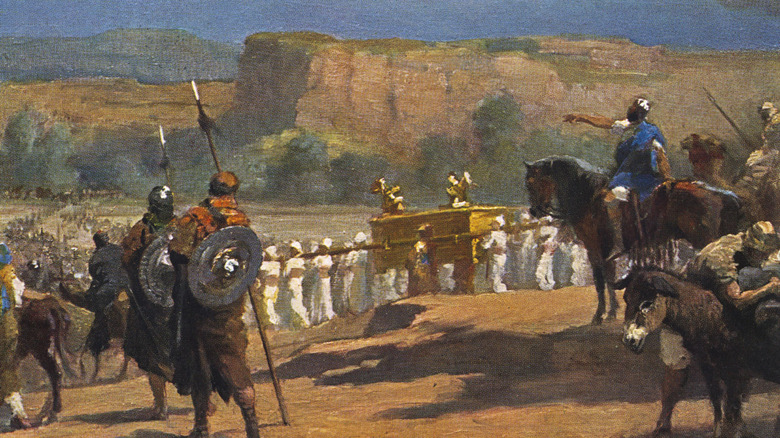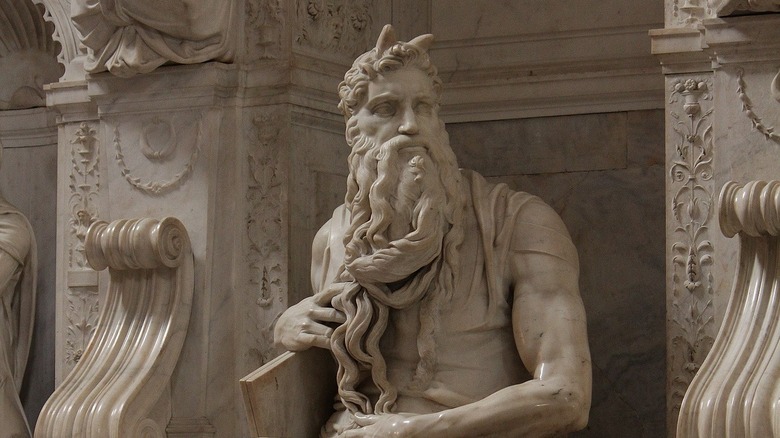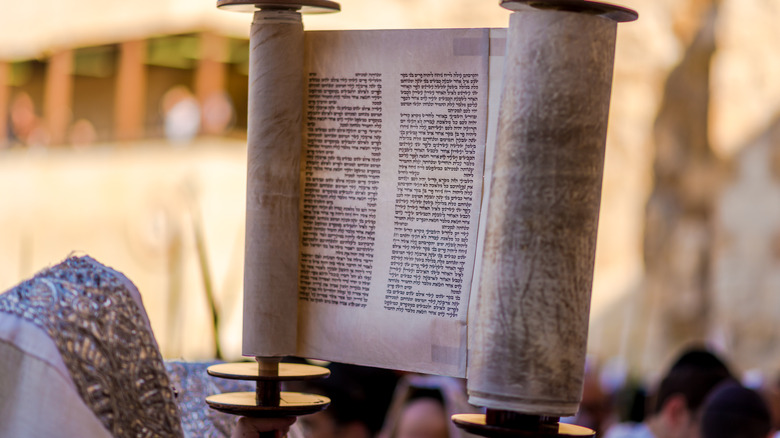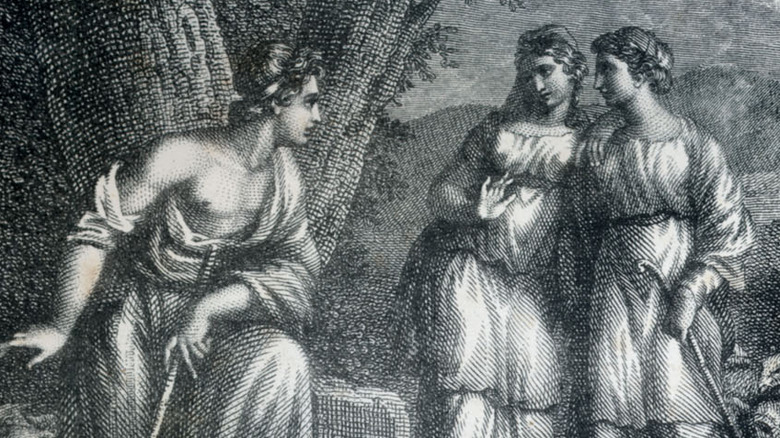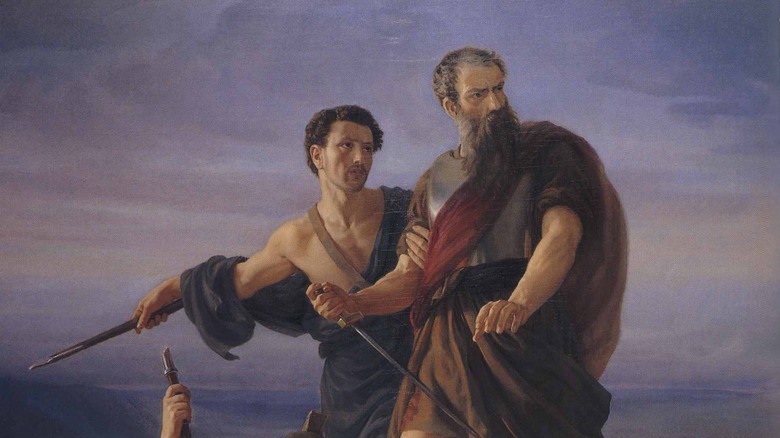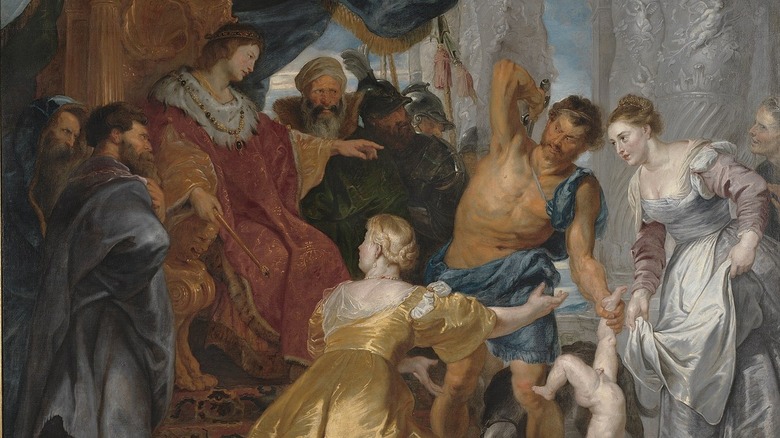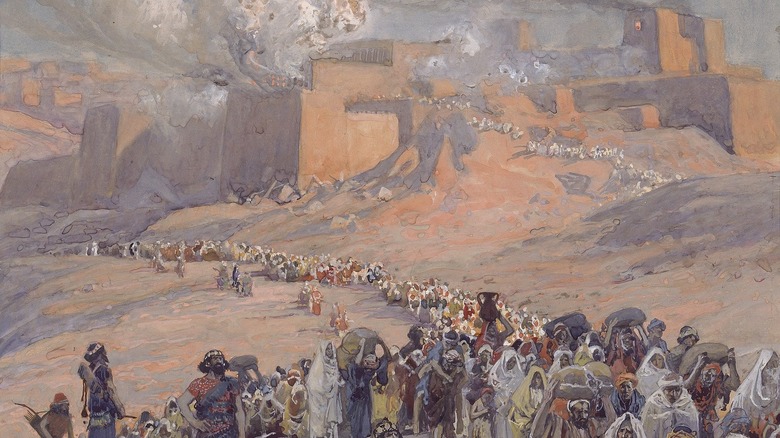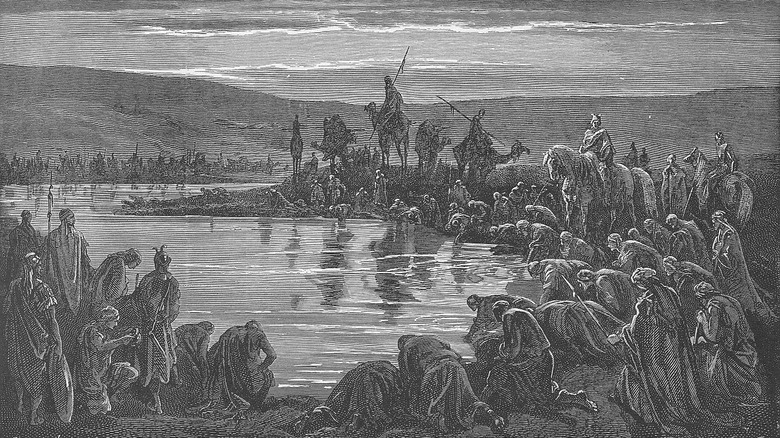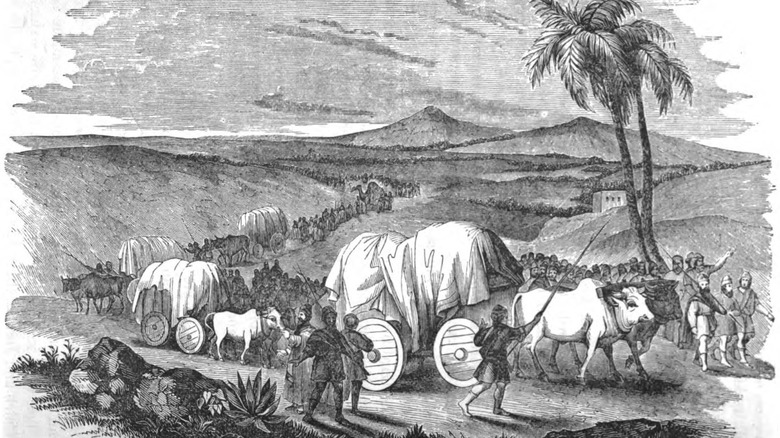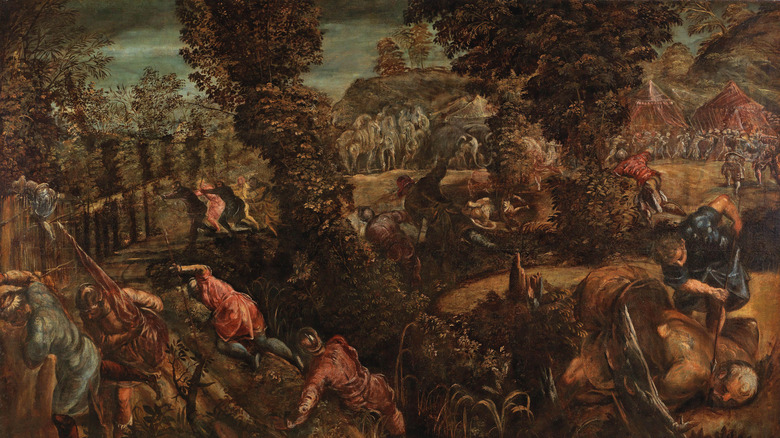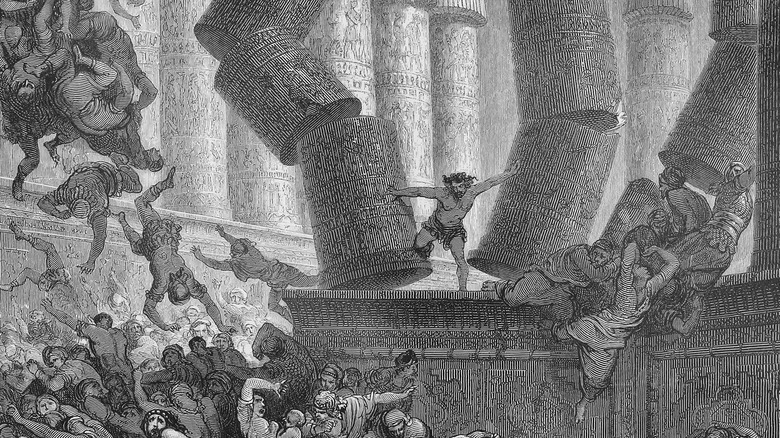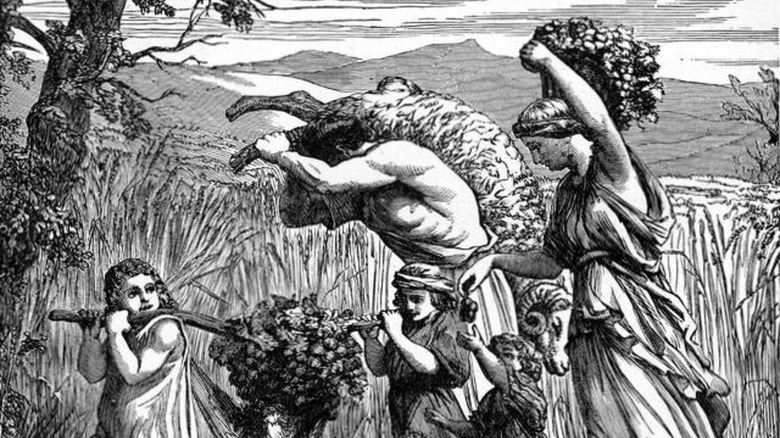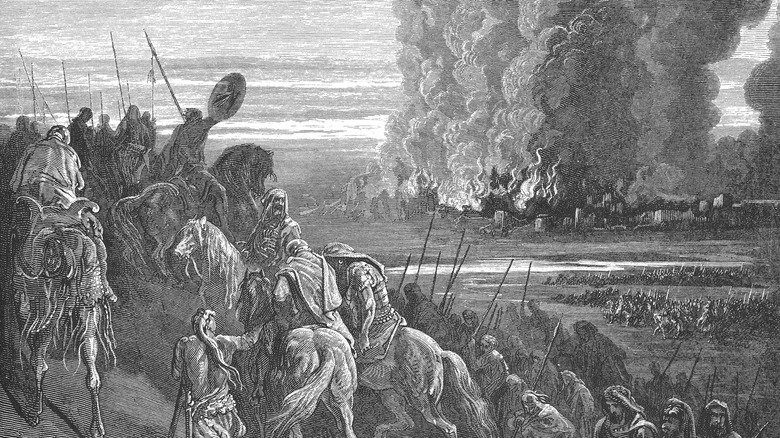The Twelve Tribes Of Israel Explained
Judeo-Christian tradition describes how the ancient land of Israel was ruled by a political confederation of 12 tribes, which were descended from the Hebrew patriarch, Jacob. As noted in "Secularizing the Sacred," historical scholars are unsure of the nature of these tribes. Were they in fact descendents of Biblical patriarchs? Were they a political alliance of tribes who had a shared religion? Did some really disappear after conquest by the Assyrians in 721 B.C.? Did these tribes even exist at all?
There are no clear answers to these questions since, as highlighted in "The Lost Tribes of Israel as a Problem in History and Sociology," historical sources are relegated to the Old Testament and whatever scant archaeological evidence emerges. All the same, the Twelve Tribes of Israel are an important symbol to modern Judaism and Christianity and are a part of the fabric of these religions. It is possible to piece together some information from religious tradition, scholarship, and new findings to create a fuller understanding of the Twelve Tribes of Israel.
What were the Twelve Tribes of Israel?
According to the Old Testament and as explained by Britannica, Jacob had multiple sons. His first wife, Leah, gave birth to Reuben, Simeon, Levi, Judah, Isaachar, and Zebulun. Jacob's second wife, Rachel, gave birth to Joseph and Benjamin. Jacob also fathered Gad and Asher with Leah's maidservant, Zilpah, and Dan and Naphtali with Rachel's maidservant, Bilhah.
According to the Old Testament the Israelites (or Hebrews) were enslaved by the pharaoh of Egypt and then freed by God through the prophet Moses. The Israelites were divided into 12 tribes named after Jacob's sons and two sons of Joseph — Manasseh and Ephraim. When the Israelites finally reached Canaan, they conquered it under the leadership of Joshua. Joshua, as noted in the article "The Twelve Tribes in the Song of Deborah," divided the land among these tribes. The only tribe that did not receive any land were the descendents of Levi, who may have became a religious class.
The tribes were ruled by a series of judges until they were eventually united under a monarchy. This monarchy fell apart after the death of King Solomon, which resulted in the establishment of the northern kingdom of Israel and the southern kingdom of Judah. After the Assyrian conquest, the 10 tribes of the northern kingdom were taken away into exile, making them the legendary Ten Lost Tribes of Israel.
How true is the Biblical account?
While some hold the Biblical account to be true at face value based on faith, much scholarship has gone into finding the underlying truth of the Twelve Tribes of Israel. As made plain by the Jewish Encyclopedia, "...such natural origin could by no means account for the numbers given in the Biblical books as the census of the various tribes. Anthropology furnishes no other example of a nation having arisen by natural descent from one ancestral family."
There is some Egyptian archaeological evidence for the existence of a people called the Israelites going back to 1200 B.C. according to PBS, although there is no substantial evidence of their enslavement.
If the tribes were not descended from these descendents of Jacob, what were they? It is believed that the tribes were a pastoral people with a shared religion and culture who lived in the Sinai peninsula and who went to Egypt during times of famine.
What's more, throughout the Old Testament there are different counts of the tribes. As described in the article "The Twelve Tribes in the Song of Deborah," the text shows no consistency in the number of the tribes. The Jewish Encyclopedia explains that the number is "probably is of mythological character, having some connection with the twelve months of the year and the twelve signs of the zodiac."
Where do the names of the tribes come from?
As for the names of the tribes, one theory explained by the Jewish Encyclopedia is that they were named after the region that the tribes lived in, and that tradition gave these names to a Biblical character after the fact. It would sort of be like if all people who lived in Montana believed a person named Montana begot all people who lived in that state. It may be that the story of the Twelve Tribes of Israel was created after the creation of Israel in order to expound upon a common origin.
To further this idea, the different "mothers" of the different tribes were a stand-in for certain differences. For example, the tribes that were named after Bilhah and Zilpah's sons were probably of lower status than those of Rachel and Leah's sons because Bilhah and Zilpah were enslaved. It also might indicate lines of descent, with Leah's tribes having more Canaanite ancestry than say Rachel's.
Whether or not the Twelve Tribes of Israel were actually real is obviously very debatable, but the story of the 12 tribes is important for our understanding of modern religious traditions. With that in mind, let's take a look at the 12 tribes to see what differences there were between them within the framework of the tradition.
The Tribe of Benjamin were left-handed warriors
Benjamin was the youngest son of Jacob and his second wife, Rachel. The small Tribe of Benjamin was located about the city of Jerusalem, but it slowly became assimilated to the much larger and powerful Tribe of Judah. The Benjaminites produced two well-known figures: Saul, the first king of Israel, and Saint Paul the Apostle.
According to the Jewish Encyclopedia, the Benjaminites were a warlike people, with Jacob prophecizing, "Benjamin is a wolf that raveneth; in the morning he shall devour the prey, at evening he shall divide the spoil." The wolf became a well-known symbol of the Benjaminites. Known as good archers, the warriors of Benjamin trained left-handed so as to better increase their skill.
One little known story of Benjamin is told in the Book of Judges. As related by TheTorah.com, a rape of a Levite by a gang of Benjaminites in the town of Gibeah led to wholesale war of the other tribes against the Benjaminites, nearly wiping them out. Afterwards, the other tribes, apparently regretting that they nearly killed all the men of Benjamin, launched a massacre against the city of Jabesh-Gilead and sent all the virgin women to the remaining Benjaminites to help them repopulate.
The Tribe of Judah was the strongest of the Twelve Tribes of Israel
Jewish tradition tells how Jacob prophesied that Judah would become the leader of all his brothers. The Tribe of Judah was composed, according to the Jewish Encyclopedia, of at least five clans. It was also the most powerful, being situated in the south and stretching up to the city of Jerusalem. The famous Israelite kings, David and Solomon, originated from Judah, whose symbol was the lion.
The Tribe of Judah had its own identity, which may be in part because it was ethnically different from the northern tribes. It was also treated differently politically, with King David establishing its land as a separate realm. In fact, Judah and the northern kingdom of Israel were often at odds, as explained by the Jewish Encyclopedia. The kingdoms often went to war against each other, as detailed by "Ancient Israel at War 853–586 BC." However, the two states were truly minor kingdoms and there were bigger forces at play.
When the huge Assyrian Empire began to expand into the region, Israel began to make alliances to resist the Assyrians and attempted to force Judah to join. Ahaz, the Judean king, called for help from Assyria and became its vassal. The Assyrians then wiped out the northern kingdom. As a result, Judah retained its own identity, and the core religion of that kingdom was the foundation for today's Judaism.
The Tribe of Ephraim were early leaders in the conquest of Canaan
The Ephraimites claim the second son of Joseph as their founder. The Jewish Encyclopedia explains that Hebrew tradition holds that the people of this tribe held a dominant position during the conquest of Canaan. Most notable among their numbers was Joshua, who took over the leadership position of the Israelites after the death of Moses. The Ephraimites settled in the central part of the kingdom.
The Tribe of Ephraim became a critical unifier in the loose association of tribes that formed the first governing structure in the days before the kings. Its geographic position, as well as also containing holy sites, made its land a place where other tribes would gather for assemblies. Politically, this tribe became the dominant force among the northern tribes and, as described by Britannica, in 930 B.C. it led the revolt that split the land into the north and south kingdoms. So strong was its position in the north that at times, "Ephraim" is used as a stand-in for "Kingdom of Israel."
The symbol of the Ephraimites was the bull, as explained by "Dreams of Subversion in Medieval Jewish Art and Literature." The Tribe of Ephraim, alongside the other northern tribes, was wiped out by the Assyrians.
The Tribe of Manasseh was split in two
Manasseh was the son of Joseph and his tribe is sometimes lumped together with that of Ephraim as the Tribes of Joseph or the House of Joseph. The Tribe of Manasseh, as explained by the Jewish Encyclopedia, had lower status than the tribe of Ephraim and had less wealth, although it occupied a broad swath of land in the northern kingdom both east and west of the Jordan River. The river split the tribe into eastern and western halves that were mainly separated from one another. However, both groups seemed to have used the unicorn as their totem, according to "Dreams of Subversion in Medieval Jewish Art and Literature." The two parts of Manasseh may have had different religious practices, which led to hostility between the two groups.
Perhaps Manasseh's most prominent figure is Gideon, who, as described by "The Military History of Ancient Israel," was a member of Manasseh's Abiezrite clan. As the Old Testament story is told, Gideon led a force of 300 against a much larger raiding army of Midianites and others. Gideon achieved victory through the use of surprise night tactics.
Members of the Tribe of Issachar were the brainiacs of the Israelites
As explained by the Jewish Encyclopedia, tradition holds that the Issacharites settled on the land west of the Jordan and southeast of the Sea of Galilee, although the Jewish Quarterly Journal expresses that some scholars believe that the Issacharites were in origin actually a Canaanite tribe.
Probably the most well-known Issacharite is Baasha, who ruled the northern kingdom in its second dynasty after he usurped the throne through murder, and then conducted more or less continuous war upon Judah. The Issarcharites, however, were known for more than just assassination and war. Even though he ruled for 24 years, after his death the people of Israel quickly deposed of Baasha's son.
Rabbinical literature holds that there was a long tradition of learning and wealth in the Tribe of Issachar. It was said that almost all students and learners were from Issachar or the Levite temple-helper tribe. Consequently, in the Old Testament, the tribe is said to have been influential among the other tribes of Israel. Its symbol, according to "Teacher's Bible Commentary" was the plow, although "Theological Dictionary of the Old Testament" says it was a donkey or ass. Either way indicates a strong work ethic.
Zebulun and Gad could kick Biblical butt
Two more militaristic tribes were Zebulun and Gad. According to Brittanica, the Tribe of Zebulun dwelt in the northeast of the Plain of Jezreel in a fertile region. As described by "Holman Old Testament Commentary – Genesis," the people of Zebulun also mingled with the people in today's Lebanon. The tribe also had a military tradition, with references going back to the Song of Deborah, the oldest section of the Old Testament, in which they wielded the staff of military command. However, in the religious texts, there are very few references to individuals of Zebulun except for Elon, who served as a judge in the era prior to the establishment of the monarchy.
Gad, as described by the Jewish Encyclopedia, was one of the strongest of Jacob's sons, which was a reflection of his tribe's warlike tendencies. The Tribe of Gad was one of the major suppliers of troops for the kingdom of Israel. Before the invasion of Canaan, the Old Testament cites that the tribe could field 40,000 men. This tribe settled on the borderlands of the kingdom, east of the Jordan, and was most known for its warlike spirit.
Some have argued that Gad was most likely a tribe that was already in existence in Canaan or at least a tribe took the name from the region known as Gad. This tribe, because it did not live in a defensible region, was easily conquered by the Assyrians and became one of the Lost Tribes alongside the Tribe of Zebulun.
The Tribe of Dan may have been Ancient Greek warriors
The Danites lived west of Jerusalem, where they came into conflict with the Philistines. The Jewish Encyclopedia notes that the Philistines had, in fact, taken territory from the Danites. It was during this time of war that one of the great heroes of the Danites arose — Samson.
According to Britannica, Samson was the son of a Danite peasant. When he reached maturity, he became a judge. Famously, Samson was superhumanly strong as long as his hair was uncut — his long hair was a symbol of his devotion to God. However, he was betrayed after he fell in love with Delilah, who learned that the source of his strength was his hair. She cut it while he slept, which allowed the Philistines to blind and enslave Samson. However, just before he died, God restored Samson's strength, allowing him to destroy a Philistine temple.
The Danites have also been traditionally considered the most wayward of the tribes, having been associated with adopting idolatry at various times. Some have thought that the name Dan actually comes from the name of another unknown Middle Eastern god. Archaeological evidence published in Haaretz suggests that the Danites may have originated in Greece. Findings of ancient Aegean artifacts in the region of Dan have shown the possibility that the Egyptians hired Greek and Syrian mercenaries to keep order in the region
The Tribes of Asher and Naphtali had the best food
Jacob and Ziphah's second son was Asher. As described by the Jewish Encyclopedia, Asher was blessed by Jacob, who said, "Asher, his food shall be rich, and he shall yield the dainties of a king."
The Asherites were given a fertile swathe of the Mediterranean coast that was most noted for its rich olive oil, thus the symbol of the tribe has traditionally been an olive tree, as explained by "The Study of the Twelve Tribes of Israel." However, scholars have difficulty actually fixing the boundaries of the tribe. Historically, Asher was more aligned with the Canaanites than with the Israelites. This has made some believe that the Tribe of Asher was associated with Israel, but not an incorporated part of it.
The Tribe of Naphtali was located in the north of Israel, centered on the city of Hazor. As detailed by the Jewish Encyclopedia, like the Asherites, this tribe had some of the richest lands in Canaan, particularly the very fertile plain of Gennesaret. King Solomon had his own son-in-law be the prefect of the region due to its natural wealth. Because of this wealth and its location in the north, the Tribe of Naphtali probably had the most cultural exchanges with the Phoenician kingdoms to the north in Lebanon. Its symbol, according to "The Encyclopedia of Jewish Symbols," was the deer. This region was one of the first to be conquered by the Assyrians.
The Tribes of Reuben and Simeon are obscure
As explained by Britannica, Reuben was the eldest son of Jacob and his first wife, Leah. The Jewish Virtual Library suggests that the Tribe of Reuben once had a place of preeminence among the tribes, but that it eventually lost that status. The Biblical explanation of this is that Jacob cursed Reuben for sleeping with his concubine.
The Reubenites lived east of the Dead Sea, according to the article "Some Suggestions concerning the History of the Tribe of Reuben." However, this has been debated since there is no clear evidence that they lived there. In fact, there is some evidence that if this tribe existed, it either became extinct or was absorbed by the other tribes.
The history of the Simeonites is equally murky. "Some Suggestions concerning the History of the Tribe of Reuben" suggests that the Simeonites were highly intermarried with the Canaanites. The Jewish Encyclopedia adds that they were among the less important tribes and may not have even existed. This is because Simeon, as described in the article "The Twelve Tribes in the Song of Deborah," was not mentioned in the Song of Deborah. Nevertheless, other traditions hold that the Tribe of Simeon was in the south of the Kingdom of Israel and bordered the much more powerful tribe of Judah. It is for this reason that some have supposed that if the Tribe of Simeon existed at all, it may have been absorbed by Judah. This tribe, as well as Reuben, is counted as two of the Ten Lost Tribes of Israel.
